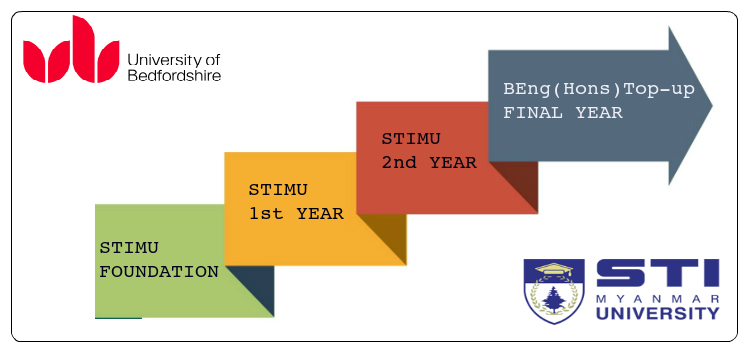BEng (Hons) Civil Architectural Engineering -(3years full-time)

- 🎓 Category : FACULTY OF ENGINEERING
- 🎓 Program : Undergraduate Programs
- 👩🎓 Course Coordinator : Dr. Thein Tan
- This is a validated Honors program awarded by University of Bedfordshire (UK).
University Of Bedfordshire
About the course
Civil & Architectural engineers apply civil engineering principles to the construction, architectural planning, and design of buildings and their structures. They often work with other engineers and with architects to focus on the function, layout, and aesthetics of building projects. They are needed to ensure that building projects are properly planned, costed, and meet the needs of the project, while taking into account engineering and architectural principles. In developing countries, a large pool of high quality, accredited civil architectural engineering graduates are needed as demand for engineers is significantly increasing due to the investment and development opportunities emerging in these nations.
Civil & Architectural Engineering degree prepares students through engagement with the fundamental concepts and practise used in structures and designs, and opportunities to innovate and be creative within these contexts. There is a focus on environmental design through the study of lightings and acoustics within building, structure or complex. The idea of combining civil engineering with architecture supports to design the creative structures. In collaboration with appreciation of architecture and civil engineering helps students to become conceptual thinkers who will be well prepared to be qualified professionals to produce integrated and sustainable designs by working together with architects, artists and other professionals within a multidisciplinary engineering environment. Students are also required to undertake a self-selected project, to develop their skills to work autonomously at a high level.
Method of Assessment
Assessment forms an integral part of the learning process. The assessment aims to enhance the learning experience rather than simply provide academic benchmarks. It allows your progress to be monitored during the course and to be enhanced by feedback from tutors, and also provides an opportunity for you to integrate your prior learning when undertaking a more focused assignment or presentation task. The assessments for level 6 will be carried out using several methods with exams and in particular developmental portfolios playing a key role.
The assessment methods used relate closely to the learning outcomes of the course and individual unit, while allowing you scope for creativity in fulfilling them e.g. by self-selection of case study examples to present within a written report within a particular health context. Assessments will in many cases be vocationally ‘sensitive’ and be designed to promote awareness of contextual policies and to promote engagement with real-life local, large and small scale architectural engineering projects.
Entry Requirement
-
Completion of the Diploma in Engineering (Civil & Architectural) Level 4 and Advanced Diploma in Engineering (Civil & Architectural) Level 5 (equivalent to HND) of the STIMU programme will allow entry onto the Level 6 award.
-
Holders of other Level 5 awards in a relevant engineering discipline will be considered for entry to Level 6
-
Applicants with relevant work experience may be considered on a case-by-case basis for Recognition of Prior Learning (RPL)
-
IELTS (5.5 overall, 5 individual) or equivalent qualifications
Course Structure
Units
|
Unit Code |
Level |
Credits |
Unit Name |
Core or option |
|
STI012-3 |
6 |
15 |
Architectural Design and Practice |
Core |
|
NEWSTI001-3 |
6 |
15 |
Engineering Design Project |
Core |
|
STI016-3 |
6 |
30 |
Civil and Architectural Engineering Project |
Core |
|
NEWSTI002-3 |
6 |
15 |
Environmental Science and Building Services |
Core |
|
NEWSTI020-3 |
6 |
15 |
Composite and Modern Materials Design |
Core |
|
NEWSTI022-3 |
6 |
15 |
Digital Analysis in Structural Design |
Core |
|
STI024-3 |
6 |
15 |
Geotechnical Engineering |
Core |
Duration – 1 year
Progression Route

Course Fees
25,900,000 MMK (Course Fees may change without prior notice)














